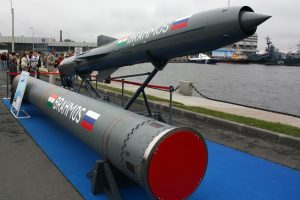As expected, the Philippines may be on the brink of becoming the first foreign buyer of the Indian-Russian BrahMos cruise missile, one of the fastest anti-ship missiles in the world, as the country’s armed forces seek to strengthen their ability to defend the country’s maritime domain from outside incursions.
Inquirer.net reported just before the new year that the Philippines’ budget department has released initial funding for the armed forces’ “planned acquisition of shore-based anti-ship missile system and combat utility helicopters.”
On December 27, the publication reported, the Philippines’ Department of Budget Management (DBM) issued two special allotment release orders (SAROs) worth 1.3 billion pesos ($25.2 million) and 1.535 billion pesos ($29.7 million). According to the DBM document, the allocations have been made “to cover the initial funding requirements for the shore-based anti-ship missile system acquisition project of the Philippine Navy.”
A senior security official told Inquirer.net that a notice of award, a written confirmation of the grant of a contract to a successful project proponent, is currently “on process” for the missile system. An additional SARO worth 1.6 billion ($31 million) was also issued by the DBM to cover the initial payment for combat utility helicopters for the Philippine Air Force.
The Philippines has long expressed interest in purchasing the BrahMos weapons system, which has been jointly developed by the Russian and Indian governments. In December 2019, Philippine Defense Secretary Delfin Lorenzana announced that Philippines was preparing to purchase two batteries of BrahMos missiles, as part of the Armed Forces of the Philippines (AFP)’s 2018-22 modernization program.
Lorenzana said at the time that he expected the contract would be signed in the first or second quarter of 2020, but negotiations seemingly came to a halt after the COVID-19 pandemic strained the Philippines’ budget. But the prospects for a deal brightened in March of last year, when India and the Philippines signed a pact known as an “implementing arrangement” opening up the possibility of government-to-government deals on defense procurements.
The world’s fastest supersonic cruise missile, the BrahMos has been developed by BrahMos Aerospace, a joint venture between India and Russia which was set up in India in 1998. The missile can be launched from submarines, ships, aircraft or from land platforms, and can carry conventional warheads weighing up to 300 kilograms. Equipped with stealth technology and an advanced guidance system, the BrahMos flies at nearly three times the speed of sound, making it nearly impossible for targets to evade.
Apart from the Philippines, countries like Thailand, Vietnam, and Indonesia have reportedly shown interest to purchase the missile. Manila’s purchase of the formidable weapons system will not only frank the increasingly close defense ties between New Delhi and Manila; it also stands to equip the AFP with a stiff deterrent against Chinese maritime adventurism in areas of the South China Sea claimed by the Philippines.
Despite winning an important international legal case that it filed against China in 2013, contesting its expansive maritime and territorial claims in the South China Sea, the Philippines has struggled to prevent repeated maritime incursions by Chinese maritime militia and coastguard vessels.
As Prashanth Parameswaran wrote in these pages in 2019, when the first reports of a potential Philippine purchase began to emerge, the missiles would be “ideal for the service’s land-based territorial defense operations.” By bringing Chinese assets in the South China Sea within the 400-kilometer range of the BrahMos missile, the acquisition could make Chinese naval commanders think twice before attempting to seize Philippine-claimed islands or features by force.
































